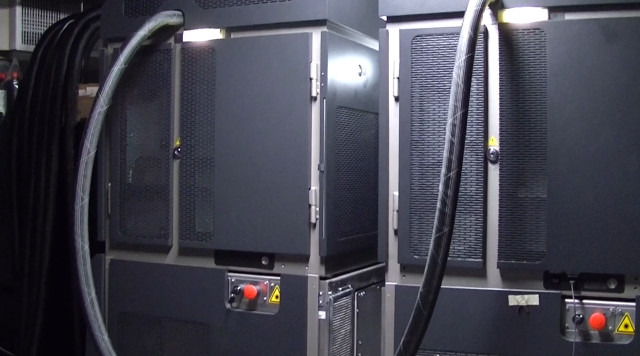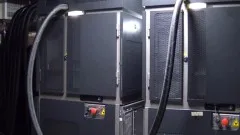When in Hollywood, you should do some sightseeing. For me, that meant a booth tour at the IMax theater adjacent to the SMPTE conference. This is located in the TCL Chinese theater (formerly the Chinese Mann theater) and is the first commercial location that IMax installed using the new laser solution.
About three years ago, the theater was renovated to accept IMax films and a film-based solution was installed as the laser projectors were just not ready at the time. In early 2014, the laser projectors were installed and in April they debuted on the Fast and Furious premiere.
Inside the projection booth, we received a tour from Thomas Larsen, the main projectionist who has watched all this unfold. First of all, this projection booth is a double-decker. Twin Christie CP4230 4K projectors occupy the upper deck with the twin IMax projectors below. The Christie projectors are not used that much – maybe 3-4 times a week and the second one is there as a spare. A RealD XL optic is used to project 3D images on a 30’x55’ screen for flat films and a 30’x70’ screen for scope films. This is done by masking of the much larger 46’x92’ IMax screen.
We could see the film running from the booth, the newly released “Crimson Peak”. This was a very unique view that was quite impressive. The image was just enormous yet looked crystal clear with amazing colors even though it is a very dark movie. I returned later that night to watch The Martian in 3D and was blown away by the presentation.

Larsen then took us below to view the IMax projectors. They are enormous – twin projectors that come in two units, with each unit weighing 800 pounds (360Kg). That’s not including the outboard chillers that occupy even more space. Larsen said they had to remove walls and use winches to get the components into the booth.
In a previous article, I describe the IMax laser solution in some detail (IMAX’s New Laser Projector is Unique in Design – and Performance). In that article, CTO Brian Bonnick noted that the limitation with current prism-based DMD designs is contrast, due to the architecture of the prism design, and sharpness, due to thermal control of the DMDs under high light loads and the resulting drift in alignment. The solution, according to Bonnick, is a new design that does away with the prism and separates the DMDs allowing air cooling of the front and liquid cooling of the back for temperature-stabilized operation under extreme light loads.
The result is a two-projector design that is a 6p solution with each projector having a different set of primaries to facilitate spectral 3D movies or 2D movies. IMax does not reveal any specifications on contrast or lumen level, but Larsen said the lasers run at around 30% of peak power and the IMax on-screen luminance spec is 22 fL, so you can do the math with a screen type assumption.
The projector is made for IMax by Barco and the chillers, 6 per projector, look like they are the same ones used in the Barco RGB projector – and maybe the same lasers as well.
One of the first things you notice is that it is cooler in the IMax area than in the Christie deck. That is not by accident. The projection system is very sensitive to heat and humidity. The temperature is controlled to just a few degrees around 70F (21ºC) and the humidity is maintained at about 50%. Dehumidifiers were added and they run at night.
The power up sequence in the morning is quite sequenced and can take 5-10 minutes. After that, an auto calibration of the audio and video takes place – every morning. The theater is fitted with 3 microphones and a camera and a number of test patterns and audio signals are used to calibrate and send the data back to IMax HQ. The whole process takes another 15 minutes. Larsen noted that with the Xenon-based IMax digital projectors, they had to warm up for 25 minutes before you could do a calibration. There is no warm up time with the lasers.
Larsen said that IMax had a person on-site for 15 months to monitor, fix and repair as needed, document and make suggestions for improvements as this was the debut site. Finding ways to maintain good temperature and humidity control remains an area that IMax and the theater continue to tweak, for example. Larsen noted that the file ingest to the projector was via a USB 3.0 port, but they often had USB 2.0 cables or drives, which slows ingest to at least the running time of the movie. Larsen says they also had to learn how to make their own DCP files so they could ingest them into the IMax projector to run trailers. That capability may have been used that very day as the files to “put on your 3D glasses” and “take them off”, were missing from the playlist for that nights’ feature – The Martian. I am not sure where those files came from in showing that night, but there they were!
The movie was great with bright, sharp, high contrast 3D images and wonderfully immersive 12-channel audio solution. IMax does not like to focus on the speeds and feeds of its solution – just the experience. And they do deliver. –CC

